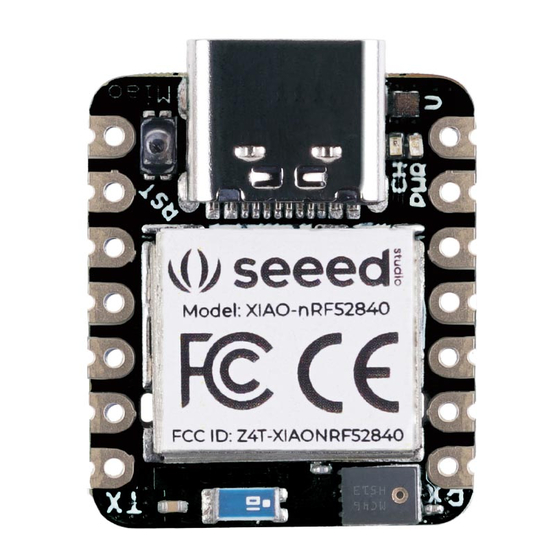
Table of Contents
Advertisement
Quick Links
Getting Started with XIAO nRF52840Sense
As the advanced version of the board XIAO nRF52840, XIAO nRF52840
Sense has equipped a powerful Nordic nRF52840 MCU which is designed in a
Bluetooth 5.0 module, built around 32-bit ARM® Cortex™-M4 CPU with
Floating-Point Unit(FPU) operating at 64Mhz. With the capabilities of wireless
connection, it still remains the XIAO series classic form-factor of small and
exquisite which can be used for wearable devices and Internet of Things
projects. Furthermore, it only costs 5 μA in the deep sleep model and it
supports battery charge management because of the BQ25101 chip.
In addition, it carries two extra onboard sensors. One of them is a digital
microphone created through Pulse Density Modulation(PDM) module on the
nRF52840 chip. It can receive audio data in real-time which allows it can be
used for audio recognition. The board not only receives audio data but also
can speak through the MSM261D3526H1CPM microphone. The other one is
6-axis Inertial Measurement Unit(IMU) which can be applied in TinyML
projects like gesture recognition. These onboard sensors provide a great
convenience for users and the ultra-small size feature of the board has still
remained.
Same as XIAO nRF52840, XIAO nRF52840 Sense contains a wealthy
interface. The first thing to note is that the Near Field Communication(NFC) is
Advertisement
Table of Contents

Summary of Contents for Seeed XIAO nRF52840 Sense
- Page 1 These onboard sensors provide a great convenience for users and the ultra-small size feature of the board has still remained. Same as XIAO nRF52840, XIAO nRF52840 Sense contains a wealthy interface. The first thing to note is that the Near Field Communication(NFC) is...
- Page 2 functional on the board. Secondly, there is a tiny and elegant reset button on one side of the Type-C interface. On the other side, it is designed in a three-in-one LED along with a power LED. There are 11 digital i/o that can be used as PWM pins and 6 analog i/o that can be used as ADC pins.
- Page 3 FCC Caution: Any Changes or modifications not expressly approved by the party responsible for compliance could void the user's authority to operate the equipment. This device complies with part 15 of the FCC Rules. Operation is subject to the following two conditions: (1) This device may not cause harmful interference, and (2) this device must accept any interference received, including interference that may cause undesired operation.
- Page 4 —Connect the equipment into an outlet on a circuit different from that to which the receiver is connected. —Consult the dealer or an experienced radio/TV technician for help. FCC Radiation Exposure Statement: This equipment complies with FCC radiation exposure limits set forth for an uncontrolled environment .This equipment should be installed and operated with minimum distance 20cm between the radiator&...
- Page 5 antenna gain is 2.0dBi. Label and compliance information When the module is installed in the host device, the FCC ID label must be visible through a window on the final device or it must be visible when an access panel, door or cover is easily re‐moved. If not, a second label must be placed on the outside of the final device that contains the following text: Contains Transmitter Module FCC ID: Z4T-XIAONRF52840, the FCC ID can be used only when all FCC ID...
- Page 6 This investigation is especially important when integrating multiple modular transmitters where the certification is based on testing each of them in a stand‐ alone configuration. It is important to note that host product manufacturers should not assume that because the modular transmitter is certified that they do not have any responsibility for final product compliance.
- Page 7 rule in Sections 15.33(a)(1) through (a)(3), or the range applicable to the digital device, as shown in Section 15.33(b)(1), whichever is the higher frequency range of investigation. When testing the host product, all the transmitters must be operating. The transmitters can be enabled by using publicly available drivers and turned on, so the transmitters are active.






Need help?
Do you have a question about the XIAO nRF52840 Sense and is the answer not in the manual?
Questions and answers